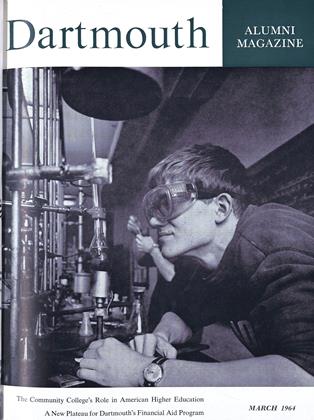THiRTEEN Dartmouth College Sophomores in their first engineering course have designed a home unit to convert brackish water to fresh water - and it has definite commercial potential.
According to their Thayer School professor. Paul T. Shannon, this is the first attempt he knows of to design a unit for home use based on the reverse osmosis principle.
The thirteen students carried out their project in the fall-term course, Engineering Science 21, which differs from many other introductory engineering courses in that it teaches the students design principles rather than analysis. The men in the course are divided into competing "companies" and given a design problem - converting brackish water was this year's problem - which they themselves work out, with the professors acting as consultants. The course lectures are designed to answer the questions that arise as the students work their way through the problem.
Many of the students will go on to do graduate work at Thayer School, where they will not only learn advanced scientific methods in engineering but will also deal with problems such as marketing, cost accounting, scheduling, and planning, so as to function effectively in the total social and economic environment.
Each of the competing companies submits its team report and design at the end of the term, with a prize going to the winning design. The panel of judges this year included William Chen of American Machine and Foundry; patent attorney William Moeser of Springfield, Vt.; Prof. Robert L. Pigford of the University of Delaware's School of Chemical Engineering Ernest H. Sieveka of the Office of Saline Water, U. S. Department of the Interior; and Dean Myron Tribus of the Thayer School.
The students who formed "Bracon" (Brackish Water Conversion) received a check and a plaque from John Dubois, editor of Design News Magazine, for their design using reverse osmosis. In addition, Mr. Chen was sufficiently impressed to invite the winning company to give a demonstration of their product before the engineers and management at American Machine and Foundry.
In designing their unit, the students first problem was to choose the water conversion method they wanted to work with, keeping in mind the home owner's needs for low cost and a simple, compact design. While other processes, such as distillation and electrodialysis, are being used in experiments being conducted by the U.S. government and private industry, the reverse osmosis process is a new field, a fact which appealed to the students in "Bracon," as did the simple design and possible low cost of the process.
The major challenge was to design and construct the model unit. The key com- ponent, an osmotic membrane, is one through which water under high pressure can be forced to pass at a much higher rate than dissolved solids can pass through. Thus the pure water passes through the membrane, leaving the salt and other minerals behind. Since the natural tendency (osmosis) would be for the-pure water to flow into the salt water, the process used in the water conversion unit is called "reverse osmosis."
The membranes used by the students were made of cellulose acetate and developed by Sidney Loeb and S. Sourirajan at the University of California at Los Angeles. The membranes are especially designed to permit as much water as possible to flow through, while allowing as little salt as possible to escape.
The brackish water entering the home is filtered, pressurized, forced through the osmotic membrane cell, and stored. Waste water leaves through one line and the fresh water from the storage tank is pumped into the home's pipes.
The unit designed by "Bracon" would furnish a home with 250 gallons of fresh water a day. The students feel that with a moderate amount of production-engineering the cost of the present hand-made unit could be decreased considerably and the unit would then be commercially competitive.
Some of the members of the winning engineering design team demonstrating theirwater purifier. Left to right; Prof. Paul T. Shannon of Thayer School, Richard Kornblum 66, Douglas P. Hill '66, Theodore A. Pittiglio '66, William Chen of AmericanMachine and Foundry, one of the judges, and Mead Over 66.
 View Full Issue
View Full Issue
More From This Issue
-
 Feature
FeatureTHE COMMUNITY COLLEGE
March 1964 By THOMAS E. O'CONNELL '50 -
 Feature
FeatureA New Plateau for Financial Aid
March 1964 -
 Feature
FeatureBOSTON'S 100th ANNIVERSARY DINNER
March 1964 -
 Article
ArticleA graduate of 1804 who stood up for an American Culture
March 1964 By BEN HARRIS McCLARY -
 Article
ArticleTHE UNDERGRADUATE CHAIR
March 1964 By DAVE BOLDT '63 -
 Article
ArticleTHE FACULTY
March 1964 By GEORGE O'CONNELL
Article
-
 Article
ArticleSPEECH OF FRANK S. STREETER, ESQUIRE, PRESIDING AT THE ALUMNI DINNER, WEDNESDAY, JUNE 26
AUGUST, 1907 -
 Article
ArticleMasthead
MARCH 1932 -
 Article
ArticleMr. Kemeny Goes to Washington
May 1979 -
 Article
ArticleMarge Tomchuk
DECEMBER 1981 -
 Article
ArticleGive a Rouse
Sept/Oct 2011 -
 Article
ArticleMILESTONES
MARCH 1931 By Craig Thorn, Jr.

